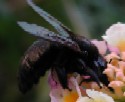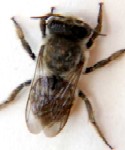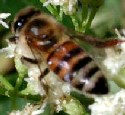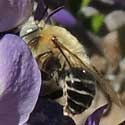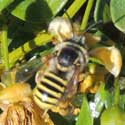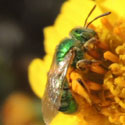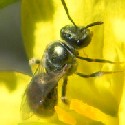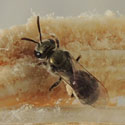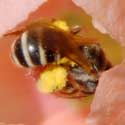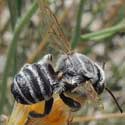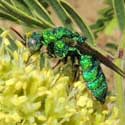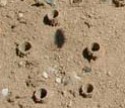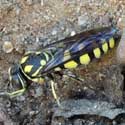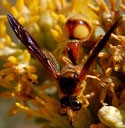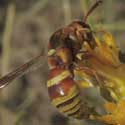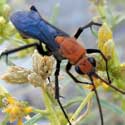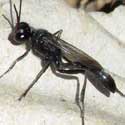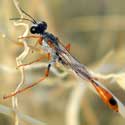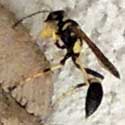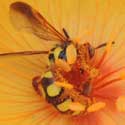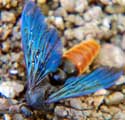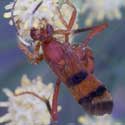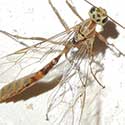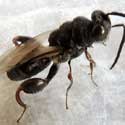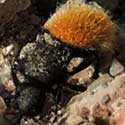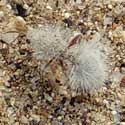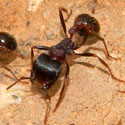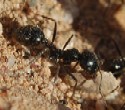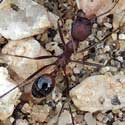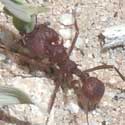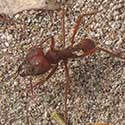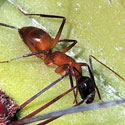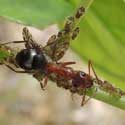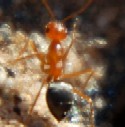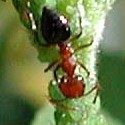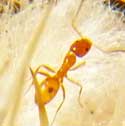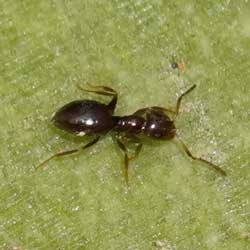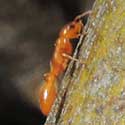Carpenter Bee
Xylocopa californica
Large, black fearsome-looking bees found especially around urban settings. Not dangerous. Frequent at paloverde flowers. More info
Leaf-cutter Bee
Megachile sp.
Very common bees at lantana and other urban flowers in the Sonoran Desert. Oval and round cuts from leaves used to build nests. More info
Honey Bee
Apis mellifera
A relatively large bee (as compared to most native bees), golden, orange-brown in color and abdomen banded orange and brown. Common everywhere. More info
Sonoran Bumblebee
Bombus sonorus
Large yellow and black bee with conspicuous pubescence. Fairly common at sunflowers, trumpets and snapdragons. More info
Cactus Bee
Diadasia spp.
Various shades of silvery-gray pubescence. Closely associated with cactus flowers. More info
Centris Bee
Centris sp.
Large bee with gray-haired thorax and nearly all black abdomen. Digs tunnels in soil to make solitary nest. More info
Digger Bee
Anthophorula ?
Distinctly banded abdomen on bee about the same size as a honeybee. This one at Larrea flowers. More info
Green Sweat Bee
Agapostemon texanus
Medium-sized bee with emerald-green thorax. Abdomen is banded yellow and black. Common around lantana. More info
Sweat Bee
Lasioglossum
Many, many difficult to separate species, but also very common in native habitats. Small (< 8mm) dark bees with sometimes a metalic sheen. More info
Sweat Bee #2
Lasioglossum sp.
This bee looks so much like the previous. But there are many, many species of sweat bees in the Sonoran Desert More info
Four-banded Nomia
Nomia tetrazonata
Medium-sized bee with four white bands on the dark abdomen. This female is gathering pollen from a mallow flower. More info
Long-horned Bee
Melissodes
Long-horn refers to the rather stout and long antennae. A number of similar species. Males have very big antennae. More info
Cuckoo Wasp
Chrysis ?
Gaudy emerald green all over. Many similar species. Often on flowers. More info
Mallow Bee
Diadasia ?
Dense aggregation of solitary bee nests in soil. Common near irrigated fields. Each bee constructs its own tunnel and provisions it solely. More info
Sand Wasp
Steniolia sp.
Lively insects hunt flies and need sandy soil to nest. Males and females visit flowers. More info
Paper Wasp
Polistes spp.
Builds papery colony nests under eaves and other protected spots. Hunts on foliage and visits flowers for nectar. Comes to water to drink. More info
Potter Wasp
Eumenes bollii
Abdomen appears double jointed. Also has dark markings on rich red and yellow abdomen. Makes small pots of mud. More info
Potter Wasp
Euodynerus pratensis
Nectar and pollen are important energy sources of pot-building and hunting activities. More info
Mexican Tarantula Hawk
Pepsis mexicana
Very large wasp with long legs. This species is all blue-black. Frequents flowers and often seen hunting running along ground. More info
Tarantula Hawk
Pepsis chrysothemis
Large, long-legged, blue-black wasps. Wings orange or reddish. Males patrol hilltops and rocky slopes in search of females. Females hunt large spiders. Also come to flowers. More info
Pompilid Wasp
Notocyphus dorsalis
Orange and blue-black pattern warns of the hard sting. This is a medium-sized spider-hunting wasp. More info
Cricket Hunter Wasp
Chlorion aerarium
Large irredescent, green-blue wasp hunts along banks of washes and ravines. Frequently enters burrows and crevices in soil. More info
Katydid Wasp
Sphex lucae
Medium sized wasps typically 12 mm long. Thin thread 'waste' between reddish abdomen and thorax. Digs tunnels in bare soil areas. More info
Katydid Wasp (male)
Sphex lucae
Medium sized wasps typically 12 mm long. Thin thread 'waste' between reddish abdomen and thorax. Digs tunnels in bare soil areas. More info
Thread Waisted Wasp
Ammophila
Elongated, very narrow, first and second abdomenal segments. Often black marked with orange or red. Digs tunnels in loose soil. Beneficial. More info
Black-and-Yellow
Mud Dauber Wasp
Sceliphron caementarium
Tubular chambers of mud are cemented to rain-protected surfaces and filled with paralyzed spiders. More info
8-Spot Scoliid Wasp
Trielis octomaculata
Long, slender, bee-like wasp with eight yellow marks on abdomen. More info
Grub Hunter Wasp
Triscolia ardens
Blue-black and brilliant orange-red. Visits flowers and hunts on ground for subterranean grubs. More info
Sawfly
Dolerus tejoniensis
Two pairs of wings as in all winged hymenoptera, but no stinger. More common species in Sonoran Desert are orange/red and black. Upper elevations in riparian habitats. More info
Red Ichneumon
Compsocryptus
Hundreds of kinds of ichneumons in the Sonoran Desert, this one showy red with black bands on wings. More info
Ophion Ichneumon
Ophion (male)
Male ichneumons wasps like this one lack the characteristic egg-laying organ called the ovipositor. More info
Chalcid Wasp
Conura (?)
Many of kinds of small chalcids in the Sonoran Desert, this one parasitized an insect that was in dead ocotillo branch. More info
